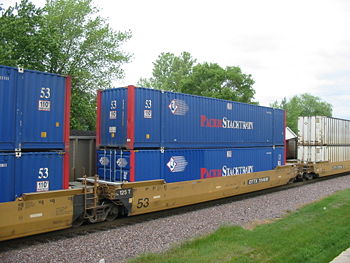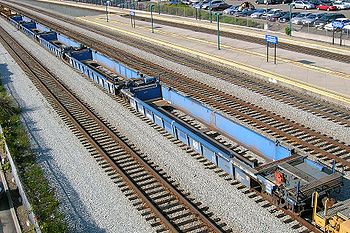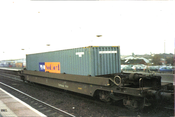- Well car
-
 A double-stack car owned by the TTX Company. The 53 ft (16.15 m) capacity car is a Gunderson Maxi-IV. The containers are owned by Pacer Stacktrain.
A double-stack car owned by the TTX Company. The 53 ft (16.15 m) capacity car is a Gunderson Maxi-IV. The containers are owned by Pacer Stacktrain.
A well car, also known as a double-stack car or stack car, is a type of railroad car specially designed to carry intermodal containers (shipping containers) used in intermodal freight transport. The "well" is a depressed section which sits close to the rails between the wheel trucks of the car, allowing a container to be carried lower than on a traditional flatcar. This makes it possible to carry a stack of two containers per unit on railway lines (double-stack rail transport) wherever the loading gauge assures sufficient clearance. The top container is held in place either by a bulkhead built into the car, or through the use of inter-box connectors.
Advantages to using well cars include increased stability due to the lower center of gravity of the load, lower tare weight, and in the case of articulated units, reduced slack action.
Double-stack cars are most common in North America where intermodal traffic is heavy and electrification is less widespread; thus overhead clearances are typically more manageable.
Contents
History
Southern Pacific Railroad (SP), along with Malcom McLean, came up with the idea of the first double-stack intermodal car in 1977.[1][2] SP then designed the first car with ACF Industries that same year.[3][4] At first it was slow to become an industry standard, then in 1984 American President Lines, started working with the SP and that same year, the first all "double stack" train left Los Angeles, California for South Kearny, New Jersey, under the name of "Stacktrain" rail service. Along the way the train transferred from the SP to Conrail.
Multiple unit cars
 A multi-unit articulated double-stack car, with five 48 ft (14.63 m) wells. This one was built by Thrall and is owned by Pacer Stacktrain. Note that there is no bottom, which would make it unsuitable to carry road trailers.
A multi-unit articulated double-stack car, with five 48 ft (14.63 m) wells. This one was built by Thrall and is owned by Pacer Stacktrain. Note that there is no bottom, which would make it unsuitable to carry road trailers.
Each unit of a double-stack car is constructed with a single well, but are often constructed with multiple units of three to five units, connected by articulated connectors. Articulated connectors are supported by the centerplate of a single truck, (often a 125-short-ton/111.6-long-ton; 113.4-tonne capacity truck but sometimes a 150-short-ton / 133.9-long-ton; 136.1 t capacity one).
Also, in a number of cases, multiple single-well cars (usually 3 or 5) are connected by drawbars and share a single reporting mark.
On both types of multiple-unit cars, the units are typically distinguished by letters, with the unit on one end being the "A" unit, and the unit on the other end being the "B" unit. Middle units are labeled starting with "C", and going up to "E" for five-unit cars.
Carrying capacity
Double-stack cars come in a number of sizes, related to the standard sizes of the containers they are designed to carry. Well lengths of 40 ft (12.19 m), 48 ft (14.63 m) and 53 ft (16.15 m) are most common. A number of 45 ft (13.72 m) wells and 56 ft (17.07 m) wells also exist. (The sizes of wells are frequently marked in large letters on the sides of cars to assist yard workers in locating suitable equipment for freight loads.)
In cases where wells are smaller than some of the containers being loaded, larger containers are often placed on top of smaller containers that fit in the available wells. Many wells are also capable of carrying two 20 ft ISO containers in the bottom position.[5]
Some double-stack cars have been also equipped with hitches which allow them to carry semi-trailers as well as containers. These are known as "all-purpose" well cars.
Other countries
 Australia - double stack trains operate between Perth, Adelaide, Darwin and Parkes, NSW[6] 6.5 m (21 ft) clearances [7]
Australia - double stack trains operate between Perth, Adelaide, Darwin and Parkes, NSW[6] 6.5 m (21 ft) clearances [7] India - Mundra Port operates double stack diesel trains on 1,676 mm (5 ft 6 in) gauge using flatcars.[8] It is one of only 3 countries to commercially double stack 9 ft 6 in (2.9 m) tall containers on a train.[9] Experiments for double stacking under 25 kV AC overhead lines have begun because of funds given by Japan.[10] [11]
India - Mundra Port operates double stack diesel trains on 1,676 mm (5 ft 6 in) gauge using flatcars.[8] It is one of only 3 countries to commercially double stack 9 ft 6 in (2.9 m) tall containers on a train.[9] Experiments for double stacking under 25 kV AC overhead lines have begun because of funds given by Japan.[10] [11] China - using double stacked container trains under 25 kV AC overhead lines. [8]
China - using double stacked container trains under 25 kV AC overhead lines. [8] Great Britain - The small structure gauges and consequently small loading gauges on the British Railways mean that double stacking is not possible and that well cars are required to be able to transport 9 ft 6 in (2.9 m) high intermodal containers.
Great Britain - The small structure gauges and consequently small loading gauges on the British Railways mean that double stacking is not possible and that well cars are required to be able to transport 9 ft 6 in (2.9 m) high intermodal containers.
Choke points
Low bridges and narrow tunnels in various locations prevent the operation of double-stack trains until costly upgrades are made. Some Class I railroad companies in the U.S. have recently initiated improvement programs to remove obstructions to double-stack trains. See Heartland Corridor (Norfolk Southern Railway) and National Gateway (CSX Transportation).
See also
References
- ^ Cudahy, Brian J., - "The Containership Revolution: Malcom McLean’s 1956 Innovation Goes Global". - TR News. - (c/o National Academy of Sciences). - Number 246. - September-October 2006. - (Adobe Acrobat *.PDF document)
- ^ Chronological History - Union Pacific Railroad Company
- ^ Kaminski, Edward S. (1999). - American Car & Foundry Company: A Centennial History, 1899–1999. - Wilton, California: Signature Press. - ISBN 0963379100
- ^ "A new fleet shapes up. (High-Tech Railroading)". - Railway Age. - (c/o HighBeam Research). - September 1, 1990
- ^ Guide to Railcars
- ^ Parkes article on double stacking
- ^ http://www.artc.com.au/library/RIS_2.2.pdf
- ^ a b Business Line - India Double Stacking
- ^ Double stack
- ^ http://www.irfca.org/gallery/openline/IRJ.jpg.html
- ^ Preparing to handle double-stack containers, Raghu Dayal, Railway Gazette International May 2009, p46
Online rosters
- Double Stack Cars - A list of double stack cars by reporting mark, with various data
- RR Rolling Stock Category: Double Stack Car - Picture Archives
Magazine articles
- Mainline Modeler:
-
- Fortenberry, Curt & Bill McKean. - "APL Container Car". - February 1987. - p.65-69.
- Fortenberry, Curt & Robert L. Hundman. - "APL container car part II the brake system". - March 1987. - p.78-81.
- Hundman, Robert L., & Curt Fortenberry. - "APL 45-foot container car". - May 1987. - p.54-57.
- Model Railroader:
-
- Durrenberger, Cyril. - "SP/ACF double stack cars". - October 1983. - p.83-93.
- Model Railroading:
-
- Bontrager, David A. - "Articulated double stacks: a prototype overview". - June 1993. p.24-29.
- Bontrager, David A. - "The Newest Prototype Well Cars: An Abundance of Kitbashing Possibilities". August 1997. - p.46-49.
- Casdorph, David G. and Ed McCaslin. - "Gunderson's Husky-Stack: The Prototype and Detailing A-Line's HO Model". - October 1995. - p.32-37.
- Casdorph, David G. - "NSC 53' Drawbarred Well Car Roster and Pictorial". - August 2002. - p.30-33
- Geiger, Doug. - "Thrall Double-Stacks: Three-Well DTTX Drawbar-Connected Car". - October 1994. - p.50-55.
- Geiger, Doug. - "Gunderson Husky Stack Three-Well BN Drawbar-Connected Car". - July 1995. - p.48-53.
- Geiger, Doug. - "Gunderson Maxi-Stack IIIs Part I: The Prototype". - December 1995. - p.58-63.
- Geiger, Doug. - "Maxi-Stack Well Car Part I: The Prototype". - April 1997. - p.28-31.
- Mansfield, Jim. - "Thrall Five-Unit Double-Stack Car - Series TWG50J". - October 1993. - p.19-23.
- Mansfield, Jim. - "Thrall Five-Unit Double-Stack Car - Series APLX 5000". - November 1993. - p.24-25, 27-31.
- Railroad Model Craftsman:
-
- Panza, Jim & Chuck Yungkurth. - "Thrall's double-stack cars". - January 1989. - p.89-98.
- Panza, Jim & Bruce Keating. - "The Gunderson Husky-Stack well car". - July 1992. - p.71-75.
- Panza, Jim & William Halliar. - "Thrall stand-alone and drawbar connected well cars". - October 1992. - p.64-68.
External links
Rail transport freight equipment Enclosed equipment Autorack · Boxcar (US) · Coil car · Container · Covered hopper · Covered wagon · Refrigerator car (US) · Refrigerated van (EU) · Roadrailer · Stock car · Tank carOpen equipment Flatcar · Gondola (US) · Hopper car · Open wagon (EU) · Modalohr · Schnabel car · Double-stack car · Mineral wagon · Slate wagonNon-revenue equipment Caboose (US) · Brake van (EU) · Work trains · Scale test car · Clearance car · Crane (railroad) · Rotary snowplowIntermodal containers Overview 
Transport Handling Container terminal · Container crane · Reach stacker · Rubber tyred gantry crane · Sidelifter · Straddle carrier · TwistlockTypes Refrigerated container · SECUOther Categories:- Freight equipment
- Rail transport terminology
- Intermodal containers
- Port infrastructure
Wikimedia Foundation. 2010.

